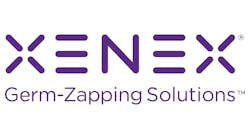Henry Ford Health System uses germ-fighting robots to combat COVID-19 in hospital rooms
Henry Ford Health System announced that it currently uses 20 Xenex LightStrike germ-killing robots across its system, including one that will assist cleaning staff at the new Brigitte Harris Cancer Pavilion opening next month.
Henry Ford was one of the first two health systems in the U.S. to deploy the Xenex UV technology robots across its hospitals in 2016.
“I love the robots, they’re my babies and part of our team,” said Jennifer Ritz, R.N., Director of Environmental Services at Henry Ford Hospital. “That’s why the robots all have names, we treat them like an extension of our team members.”
Although the robots have been affectionately branded with names like Zappy, Germin8or, Apollo, Brigitte, Ripley, Flash and Lamont they serve a very serious role in the fight to reduce the spread of COVID-19. The robots emit ultraviolet lights that destroy deadly microorganisms and help reduce infection rates in patients and healthcare workers.
More health systems and major airports across the country have invested in the UV robotic disinfection approach since the start of the pandemic to more thoroughly and efficiently sanitize, public high-contact areas. The robots have proven effective as an addition to the CDC infection control protocols by more than 40 peer-reviewed studies on reductions of pathogens on surfaces. The robot’s disinfection cycle eliminates 99.99percent of SARS-CoV-2, the virus that causes COVID-19.
“Our leadership at Henry Ford Health System has put their support behind the program for years,” said Ritz who previously served as the manager of regulatory infection control quality at Henry Ford Hospital and understands the important role the robots play in fighting infection. “Leadership values the enhanced safety measure the robots provide that ensures our facilities are properly disinfected to protect our patients and staff.”
The UV robots are also an integral part of Henry Ford’s Promise throughout the pandemic, a commitment to providing the safest, highest quality experience possible. The machines are an extension of the Environmental Services (EVS) staff who operate them to thoroughly disinfect vital patient care areas throughout the hospital. When activated, the robot sends pulses of UV-C light beams that reach every surface of the room and eliminate germs by unraveling and destroying their cell structure.
Studies have shown that not all hard-to-reach surfaces in a typical hospital room are disinfected with standard cleaning techniques. The robots help reduce the risk of infection by destroying microscopic germs that may be missed during the manual cleaning process. Since their introduction, data trends show that the robots have helped to lower hospital-acquired infections nationally.
Henry Ford EVS employees manually clean and disinfect patient rooms according to Centers for Disease Control and Prevention (CDC) recommendations and best practices. The cleaning crew then brings in the robot to perform the additional UV light system disinfection treatment that eliminates potentially harmful bacteria and viruses from every surface, nook and cranny not visible to the human eye. On average, one robot can disinfect up to 15 rooms in an eight-hour shift.
Disinfection cycle time depends on the size of the room. A standard inpatient room typically requires three cycles lasting five minutes each and target the two sides of a room plus the restroom. An ICU room requires two cycles of five minutes each while an operating room can take two cycles of 10 minutes each, depending on its size. Each day, the EVS team uses the robots to clean and disinfect patient and operating rooms, labor and delivery and ICU rooms, and isolation discharge rooms.
“We have a standard operating procedure for each facility, depending on room types that tell us exactly how many cycles are required in each room,” said Ritz. “When a room has been cleaned and disinfected by human hands and the robot, our team members leave a card to reassure new patients and staff that it is a clean and safe environment for them.”
The EVS team also uses the robots for “terminal cleaning” of hospital units during the pandemic. For instance, units that may have previously cared for COVID-19 patients receive a complete stripped-down cleaning which ensures the unit is made safe for new non-COVID patients. “The patient rooms are taken down to the bare bones, they’re cleaned and disinfected by our team, and then we put them back together,” said Ritz.
The robots are also supported by Henry Ford’s Clinical Engineering Department when repairs and maintenance are needed. Biomedical equipment technicians are trained and certified by the robot’s manufacturer to troubleshoot and keep the machines working properly.

